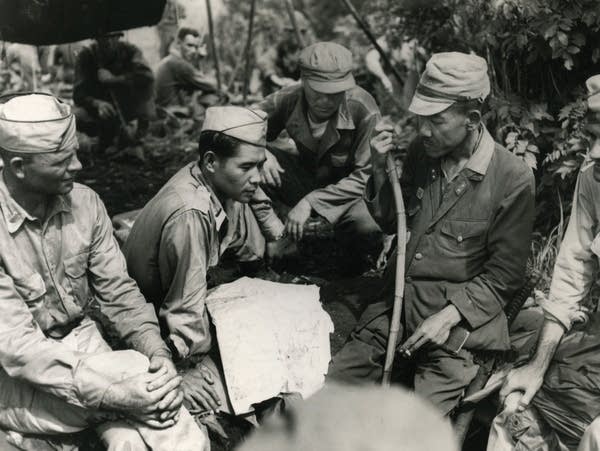Exhibit traces history of secret language school at Fort Snelling

A new photo exhibit at Historic Fort Snelling in Minneapolis invites viewers back in time to World War II, when the fort housed a secret language school.
The Military Intelligence Service Language School trained second-generation Japanese-American men, or nisei, to be interpreters in the Pacific Theater. The Twin Cities chapter of the Japanese-American Citizens League mounted the new exhibit in connection with the Minnesota Historical Society. It opened on Saturday.
"There were so many acts of heroism and bravery," said Sally Sudo, a member of the education committee of the Twin Cities Japanese-American Citizens league. "Because of the fact that they looked like the enemy, if they were out of uniform, they could be killed easily by friendly fire."
Once trained, the men served with U.S. and Allied forces across the Pacific, working as interpreters and interrogators of Japanese prisoners. They also translated captured documents and participated in cave flushing, calling through loud speakers to encourage Japanese soldiers hiding in caves to come out. The intelligence they provided proved vital to the war effort.
Create a More Connected Minnesota
MPR News is your trusted resource for the news you need. With your support, MPR News brings accessible, courageous journalism and authentic conversation to everyone - free of paywalls and barriers. Your gift makes a difference.

Sudo and her family were in an internment camp when her 17-year-old brother Joe Ohno volunteered to join.
"You think about the irony," said Sudo, "the fact that the reason we were rounded up and put into internment camps is that supposedly we couldn't be trusted. We were supposedly going to commit acts of sabotage or espionage. And then to think that now the military wants you to serve in their military intelligence service? And the fact that so many of them volunteered with their families still behind barbed wire. Isn't that kind of ironic?"
Sudo spent 3 1/2 years in internment. When she and her family were released, they moved to Minnesota because of her brother's positive report about the state. Many of the people in the Twin Cities Japanese-American Citizens League who worked on the exhibit did so because of a family connection to the language school.
Minnesotans who served in World War II also weighed in on creating the exhibit.
According to Sudo, fewer people than military officials might have expected had the Japanese language ability necessary to train as interpreters.
"Out of the whole population, only about 3 percent of them were fluent enough in Japanese to fill the role that they expected. They didn't realize that our generation had become so Americanized that we were not fluent in our own native language any more or could barely read or write it," she said.
In 2010, President Barack Obama awarded the Congressional Gold Medal to thousands of Japanese-American veterans, recognizing their service to their country.
Located in the gallery of the visitors' center at Historic Fort Snelling, the free exhibit will be open until Labor Day.